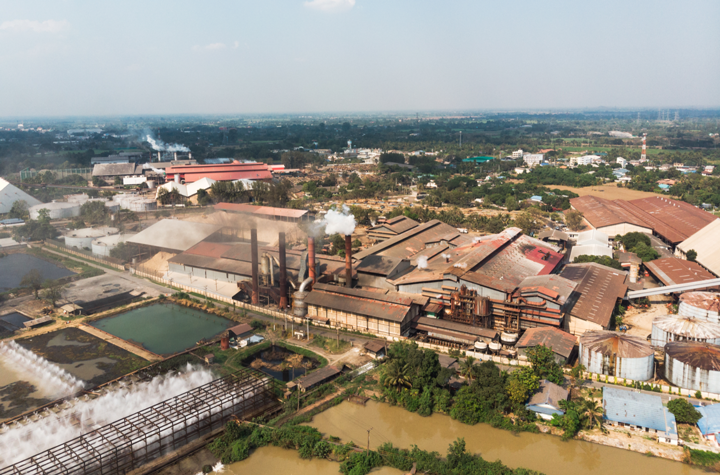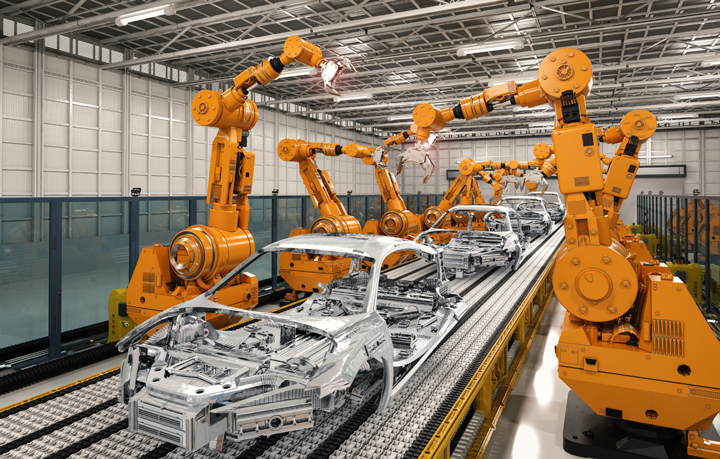We’ll take a look at just some of the ways manufacturing companies can benefit from implementing AI in their processes. Furthermore, we’ll share the diverse applications of AI that will help you save costs and improve processes regardless of the product specifics.
AI in Manufacturing: Reshaping the Future of the Industry
Iva Hadzheva, Marketing Specialist | Accedia
In 2022 AI in Manufacturing is valued at USD 2.3 billion and is projected to reach 16.7 billion by 2027 according to a recent report. The result of adopting AI in any shape or form – from automation and predictive analytics, to natural language processing (NLP) and computer vision, can be seen in early adopters such as IBM, Intel, GE, Siemens, and their success and business growth.
In this article, we’ll take a look at just some of the ways manufacturing companies can benefit from implementing AI in their processes. Furthermore, we’ll share the diverse applications of AI that will help you save costs and improve processes regardless of the product specifics.
WHY ADOPT AI IN MANUFACTURING?
As Harald von Heynitz, Head of Industrial Manufacturing, KPMG has said “Taking advantage of advances in robotics, 3D printing, and AI is critical to driving greater efficiency, lowering costs, and improving safety for many sectors and particularly niche suppliers”. The benefits AI brings to Manufacturing are twofold. On one hand, we see the unprecedented growth and scalability it provides to the business, and on the other – the positive impact on the employees and their productivity and satisfaction. Read along to find out more about how AI will change the face of industrial Manufacturing.
ACCEDIA’S MANUFACTURING PORTFOLIO
PREDICT DEMAND FORECASTING
Forecasting inventory stock levels and demand has always been a challenge. While old-school methods such as Excel sheets and probabilities, based on last year’s demand and sales, may have worked before, now AI helps reach a new level of accuracy. Using large amounts of historical data, trends, and current events, and leveraging the right AI tools and ML models to forecast business needs guarantees the highest levels of precision. This includes every part of the supply chain. Which products are selling the fastest in certain parts of the year, when the demand fluctuates, how fast the company runs out of certain items, and much more. So collecting historical data and enriching it with real-time data gives an accurate picture of the demand outlooks. It also increases sales and inventory turnover, while reducing costs and overproduction.
REDUCE CARBON EMISSIONS

According to the World Economic Forum, one-fifth of the world’s carbon emissions come from the Manufacturing industry. This includes waste, overproduction, and of course – carbon emissions from fossil fuels. Thus, using technology to minimize the negative impact production has on the environment is an aspect organizations should all address sooner rather than later. Having already embraced digitalization, the next step in front of big or small Manufacturing companies is to become more transparent with the collected data. This will not only benchmark decarbonization efforts but will also gain trust among customers. Using AI technologies to monitor emissions throughout the production process, transportation, equipment, and more allows access to what the carbon footprint actually entails. Organizations can, thus, optimize their efficiency, forecast emissions, and plan according to future demand and regulations.
ENABLE PROCESSES OPTIMIZATION
AI can help organizations transform and optimize both internal and external processes by maximizing productivity and profitability. Workflow changes then impact costs, production quality, delivery, and every other aspect of the production process. One of the biggest improvements to the product lifecycle is automation. Some of the benefits it provides include reducing costs and time-to-market by automating complex or repetitive tasks and eliminating the risk of human-prone errors, achieving a more scalable production line, increasing productivity, and minimizing energy consumption.
INCREASE EMPLOYEE SATISFACTION
Introducing AI into the Manufacturing process has just as important and valuable an impact on the satisfaction and mental health of employees. According to a study, AI improves the mental health, particularly of low-skilled employees by 2.342 points and 2.070 points for workers born before the 1980s. Those numbers are not a surprise if we consider the effect AI can have not only on the business side of Manufacturing but also on the company employees. It decreases over time, helps learn new skills and technologies while shortening the time required for onboarding, and overall improves the work environment. Additionally, embracing AI increases employee productivity by allowing for repetitive tasks such as data entering and creating Excel sheets to be automated. Thus, leaving employees more time to focus on other more important aspects of their work.
DIGITAL TRANSFORMATION ROADMAP FOR MANUFACTURING
APPLICATION OF AI IN MANUFACTURING
ADVANCED QUALITY ASSURANCE AND VISUAL INSPECTION
Quality assurance can often be an afterthought which then results in additional unplanned costs, delayed time-to-market, customer dissatisfaction, and a decrease in the company’s reputation. With the goal to eliminate those risks, Accedia created a solution for one of our clients in the Manufacturing industry to help their employees, engineers, and clients in forecasting future failures in the production of bearings. The project utilizes Machine Learning and Computer Vision models to recognize and classify damages in uploaded pictures of malfunctioned bearings. The robust cloud distribution allows for the benefits of predictive analytics to spread across the client’s factories worldwide and detect production errors way before the bearings reach the final customer. It also allows the carrying out of a precise root-cause analysis and production optimization. As one McKinsey report says AI can increase defect detection by 90% in comparison to human inspection.
ROBOTICS

According to a recent study, about 90% of all robots used today, can be found in manufacturing facilities. When talking about robotics in Manufacturing, though, people often think of hardware. Robotics, however, relies just as much on hardware as it does on the software behind it. Using advanced AI and ML models robots can perform tasks in production factories much faster than people, whilst eliminating the risk of errors. All robots specialize in particular tasks and are completely independent of human supervision. This means that while robots are in charge of assembly, material handling, welding, material dispensing, or removal, employees can focus on more advanced and business-crucial tasks.
Using robotics on Manufacturing floors will very likely attract bigger sales, and higher investments, and will increase quality and repeatability. It will greatly improve flexibility, and speed to market. Automating the Manufacturing process and outsourcing tasks to robots will allow the allocation of the salary budget to retraining talents and supporting business growth.
ISSUE REPORTING
The most common approach to issue reporting, made possible through AI and specifically Natural Language Processing (NLP), is the chatbot. NLP is a fairly new technology that can understand unstructured human language and transform it into structured data which is then analyzed. Using chatbots Manufacturing employees can at all times get accurate real-time information about processes of different production levels, machinery parts, and their condition, which is very important especially when it’s a time-sensitive matter. Other NLP and chatbot use cases can include customer support automation, delivery or update notifications, managing floor queries, inventory, and supplier checks. The benefits for the entire organization are countless – quick and easy access to databases and knowledge, improved efficiency and operations, and innovative interactive experience for the end-user.
CYBER SECURITY
Another important use case of AI in manufacturing is industrial cyber security. This may include IoT compromise, supply chain infection, phishing, intellectual property theft, and even ransomware, which can result in the loss of a large amount of money and valuable data. And, unfortunately, being such a lucrative industry, manufacturing is an obvious target for hackers. As a result just in 2020 alone, over 40% of manufacturing companies suffered a cyber attack. The examples range from small and middle-sized organizations to leading manufacturers. We remember the attack against the automobile manufacturer Honda or the ransomware against Renault-Nissan in 2017.
Adopting recommended security guidelines and cybersecurity frameworks is a must for all. However, that can sometimes not be enough to address the threats and minimize risks. Thus, relying on AI-driven cybersecurity strategies is becoming the new norm. It allows the detection of malicious internal reconnaissance behavior, command-and-control attacks (including the usage of external remote access tools), SMB brute-force attacks, account scans, and more. AI can detect all those threats and attacks in real-time and undertake remediation steps much faster, more efficiently, and accurately. It can also collect data from all network traffic, analyze logs, and events, and predict threats.
WHAT DOES THE FUTURE HOLD FOR AI IN MANUFACTURING?
According to a recent report by Deloitte:
- It is estimated that Manufacturing is generating around 1,812 petabytes of data each year, which puts it in first place way ahead of retail, finance, communications, and other industries.
- 93% of Manufacturing companies are confident that AI will drive growth and innovation to the entire business sector.
- 83% of surveyed companies believe that AI has or will have a positive impact on their profits.
As the global market is becoming increasingly competitive more manufacturing sectors are joining the AI game – food, pharmaceuticals, chemical, automotive, electronics, and more. The increased implementation of the AI technology stack, however, won’t come without its challenges. The number one blocker in front of companies looking into AI is the need for skilled talent and the lack of trust they have in in-house resources. Thus, as early adopters have shown us, the best way to approach this daunting task is by outsourcing it to dedicated AI teams.
ACCEDIA AI AND MACHINE LEARNING SERVICES
CONCLUSION
You can now see the numerous applications AI has in Manufacturing and its benefits in predicting maintenance needs, optimizing manufacturing processes, managing supply chains, scaling, or quality control. And if before increasing parameters such as sales and quality, while decreasing costs was somewhat of a utopia, the right AI technology stack and software partner can make it a status quo. Thus, believing in the future of AI not only in Manufacturing but throughout all industries, Accedia created its own AI Capability Center, where our focus is to unlock new opportunities with the successful utilization of ML and AI technologies.
The content & opinions in this article are the author’s and do not necessarily represent the views of ManufacturingTomorrow
Comments (0)
This post does not have any comments. Be the first to leave a comment below.
Featured Product

